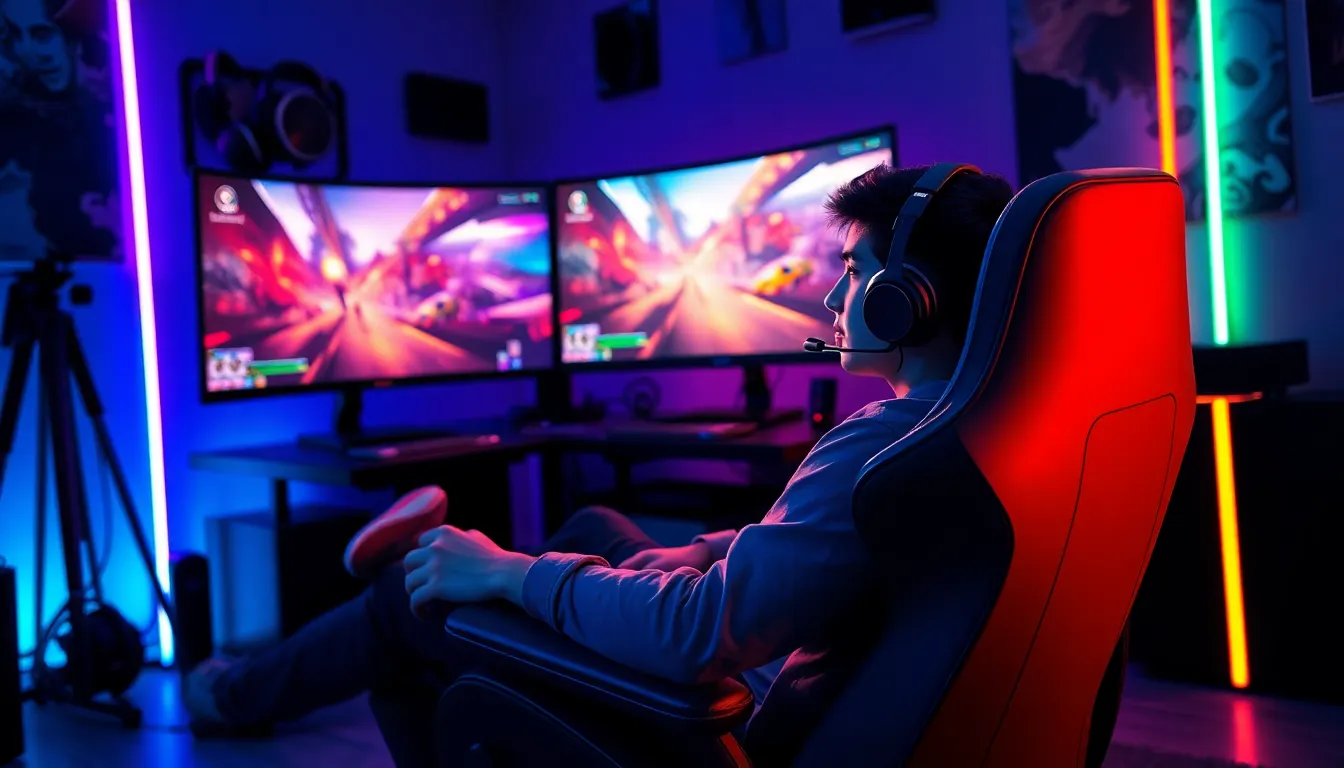In the epic showdown of gaming monitors, two contenders step into the ring: the suave curved monitor and the classic flat panel. Each promises to elevate the gaming experience, but which one truly reigns supreme? Picture this: you’re deep in battle, and your flat monitor is like a straight line in a world of curves, leaving you feeling a bit… well, flat. Meanwhile, the curved monitor wraps you in a panoramic embrace, making you feel like you’re inside the game rather than just watching it unfold.
Curved vs Flat Monitor Gaming
Curved monitors feature a distinct design that enhances immersion. These displays wrap around the user, creating a panoramic effect. By doing so, they draw attention and provide a wider field of view. Gamers often find that this curvature reduces eye strain during long sessions.
Flat monitors, on the other hand, provide a traditional viewing experience. Their straightforward design makes them popular among various users. While offering less immersion, flat displays excel in color accuracy and screen clarity. Some players prefer these characteristics when playing competitive games, where precision matters most.
Both monitor types offer different refresh rates and response times. Curved monitors often operate at high refresh rates, facilitating smooth visuals during fast-paced gaming. Flat monitors also provide excellent refresh rates, appealing to competitive gamers who prioritize speed.
Accessibility plays a key role in selecting between the two. Curved monitors typically cost more due to their advanced technology and design. Flat monitors offer a wider range of price points, accommodating various budgets.
Ultimately, preferences guide the choice between curved and flat monitors. Curved models stand out for immersive gaming experiences, while flat displays shine in performance accuracy. Understanding these differences helps gamers make informed decisions tailored to their gaming styles.
Benefits of Curved Monitors

Curved monitors offer various advantages for gaming enthusiasts looking for an enhanced experience. With their unique design, these monitors can transform gameplay significantly.
Immersive Experience
Curved monitors enable gamers to feel as though they are part of the action. The wrap-around effect created by the curvature draws users into the game, making visuals appear more engaging. This design promotes a broader field of view, allowing players to focus on critical details without turning their heads excessively. Gamers frequently report heightened immersion during longer gaming sessions with these displays. As a result, the curved design helps create a three-dimensional effect that flat monitors can’t replicate.
Reduced Eye Strain
Curved monitors contribute to reduced eye strain, especially during extended periods of gaming. The natural curve aligns better with the shape of the human eye, making it easier to focus on content without constant adjustments. Flat monitors often force eyes to strain as users shift focus across different sections of the screen. With a curved display, the user’s peripheral vision benefits from the curved edges, dispersing visual information more evenly. Consequently, this design aids viewers in maintaining comfort and reducing fatigue, leading to more enjoyable gaming experiences in longer sessions.
Advantages of Flat Monitors
Flat monitors offer several benefits that appeal to a wide range of gamers. Their traditional design ensures familiarity, making them an accessible choice for many.
Affordability
Affordability is a significant advantage of flat monitors. They typically come at a lower price point compared to curved models, making them accessible for budget-conscious gamers. Many entry-level flat monitors provide excellent features, such as high refresh rates and quick response times, catering to competitive gameplay. Gamers can find quality options without breaking the bank, supporting various resolutions and sizes. This price range enables a larger number of players to invest in gaming monitors.
Screen Real Estate
Screen real estate plays a crucial role in user experience. Flat monitors often provide a more straightforward setup for multi-monitor configurations. Gamers can arrange several flat monitors side by side, maximizing their field of view for an expansive gaming experience. Additionally, many flat models deliver superior pixel density, enhancing clarity and detail. Usage in professional environments also benefits from this design, as it accommodates multitasking and productivity, making flat monitors versatile tools for both gaming and work.
Performance Considerations
Performance is crucial for any gaming experience. Curved and flat monitors each have unique attributes affecting gameplay.
Refresh Rate and Response Time
Refresh rates and response times significantly impact gaming performance. Curved monitors often offer refresh rates up to 240 Hz, providing smoother visuals during action-packed moments. Competitive gamers benefit from this high refresh rate, as it reduces motion blur and ensures fluid gameplay. Response times on these monitors can be as low as 1 ms, enhancing responsiveness. Flat monitors also provide impressive refresh rates, typically ranging from 60 Hz to 144 Hz, making them suitable for various gaming genres. Their response times can match or exceed curved models in certain instances. Gamers should evaluate their gaming style to select a monitor that offers the ideal balance of refresh rate and response time.
Graphics Quality
Graphics quality plays an essential role in monitoring performance. Curved monitors often provide a broader field of view, enhancing immersion with more vivid colors and contrast. This design helps in delivering an engaging gaming environment. Models with 1440p or 4K resolution amplify detail, making visuals more lifelike. Flat monitors excel in color accuracy, delivering sharp images that cater to professional environments as well. Gamers notice clearer text and finer details on flat displays. Both monitor types offer excellent graphics quality, but personal preference influences the final choice. Optimizing for resolution, color reproduction, and immersive experience guarantees a rewarding gaming experience.
Choosing the Right Option for Gaming
Selecting the right monitor for gaming involves evaluating personal needs and preferences, along with understanding the space available to set it up.
Personal Preferences
Personal preference significantly impacts the choice between curved and flat monitors. Many gamers enjoy the immersive feel that curved displays provide, which wraps around the peripheral vision. Some players prioritize screen curvature for its enhanced depth perception during gameplay. Comparatively, flat monitors attract those who favor a traditional feel and superior color accuracy. Competitive gamers often choose flat screens for precise targeting and quick responses. Preferences also hinge on genre; racing and simulation gamers might opt for the enveloping experience of a curved model, while first-person shooter enthusiasts lean towards flat screens for optimal clarity.
Space and Setup Requirements
Space and setup constraints influence monitor choice. Curved monitors typically require more desk depth to accommodate their design. It’s crucial to ensure adequate viewing distance to avoid distortion. Consider the dimensions and layout of the gaming space when selecting a curved monitor, as they work best in a central position. On the other hand, flat monitors fit into tighter spaces more easily. Their design allows them to be positioned against walls or in compact setups. While larger flat monitors provide a great viewing experience, ensuring the screen size aligns with the viewer’s distance remains essential.
Conclusion
Choosing between a curved and flat gaming monitor ultimately depends on individual preferences and gaming styles. Curved monitors provide an immersive experience that enhances gameplay with a wider field of view and reduced eye strain. They’re ideal for those who enjoy racing or simulation games.
On the other hand, flat monitors excel in color accuracy and clarity, making them a top choice for competitive gamers who prioritize precision. They fit well in various setups and are versatile for both gaming and professional tasks.
Understanding these differences can help gamers make an informed decision that aligns with their unique gaming needs and preferences.

